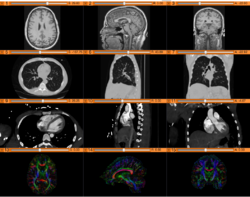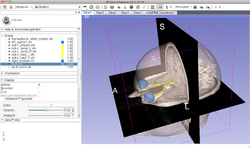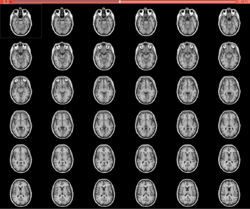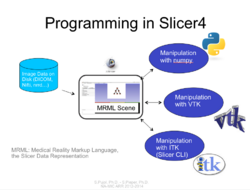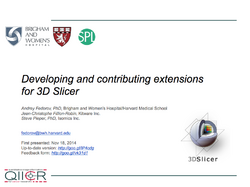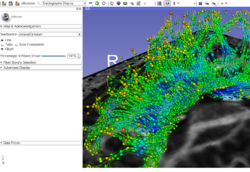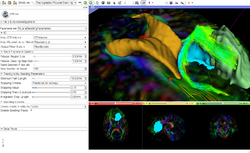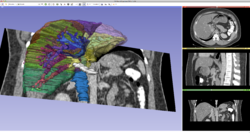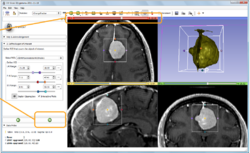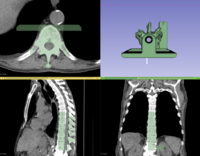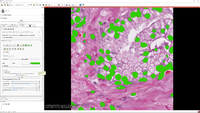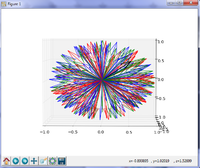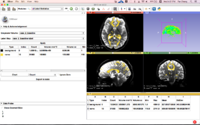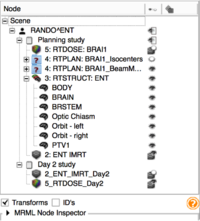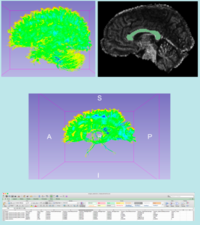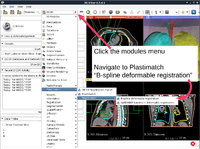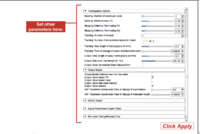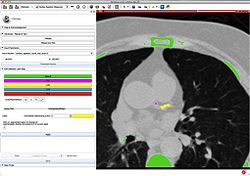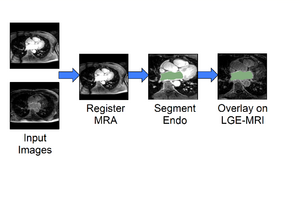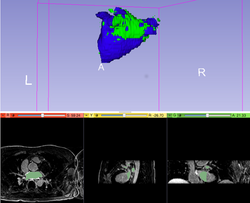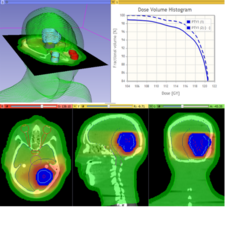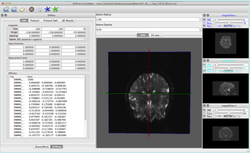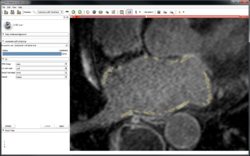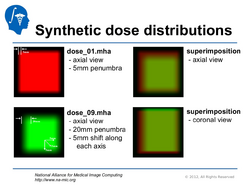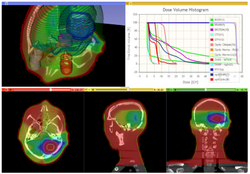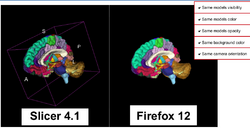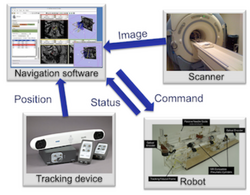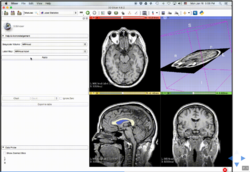Difference between revisions of "Documentation/4.6/Training"
From Slicer Wiki
(Nightly -> 4.6) |
Tag: 2017 source edit |
||
| (35 intermediate revisions by 7 users not shown) | |||
| Line 1: | Line 1: | ||
| − | <noinclude>{{documentation/ | + | <noinclude>{{documentation/historicaltraining}} |
=Introduction: Slicer {{documentation/version}} Tutorials= | =Introduction: Slicer {{documentation/version}} Tutorials= | ||
| − | * | + | *The 3D Slicer compendium is a collection of hands-on tutorials with anonymized sample data sets. The tutorials demonstrate how to use the 3D Slicer software platform (version {{documentation/version}} release) to accomplish certain tasks. |
*For tutorials for other versions of Slicer, please visit the [[Training| Slicer training portal]]. | *For tutorials for other versions of Slicer, please visit the [[Training| Slicer training portal]]. | ||
*For "reference manual" style documentation, please visit the [[Documentation/{{documentation/version}}|Slicer {{documentation/version}} documentation page]] | *For "reference manual" style documentation, please visit the [[Documentation/{{documentation/version}}|Slicer {{documentation/version}} documentation page]] | ||
| − | *For questions related to the Slicer4 Training Compendium, please send an e-mail to '''[http://www.na-mic.org/Wiki/index.php/User:SPujol Sonia Pujol, Ph.D]''' | + | *Some of these tutorials are based on older releases of 3D Slicer. The concepts are still useful but bear in mind that some interface elements and features will be different in updated versions. |
| − | + | *For general questions related to the Slicer4 Training Compendium and to 3D Slicer training events, please send an e-mail to '''[http://www.na-mic.org/Wiki/index.php/User:SPujol Sonia Pujol, Ph.D, Director of Training of 3D Slicer]''' | |
| − | |||
| − | |||
| − | |||
__TOC__ | __TOC__ | ||
| − | |||
=General Introduction= | =General Introduction= | ||
| − | |||
==Slicer Welcome Tutorial== | ==Slicer Welcome Tutorial== | ||
{|width="100%" | {|width="100%" | ||
| Line 29: | Line 24: | ||
{|width="100%" | {|width="100%" | ||
| | | | ||
| − | *The [[media:Slicer4.5minute_SoniaPujol.pdf|Slicer4Minute | + | *The [[media:Slicer4.5minute_SoniaPujol.pdf|Slicer4Minute Tutorial]] is a brief introduction to the advanced 3D visualization capabilities of Slicer 4.5. |
*Author: Sonia Pujol, Ph.D. | *Author: Sonia Pujol, Ph.D. | ||
*Audience: First time users who want to discover Slicer in 4 minutes. | *Audience: First time users who want to discover Slicer in 4 minutes. | ||
| Line 47: | Line 42: | ||
*Audience: End-users | *Audience: End-users | ||
*Based on: 3D Slicer version 4.5 | *Based on: 3D Slicer version 4.5 | ||
| − | *The [[Media:3DVisualizationData.zip | | + | *The [[Media:3DVisualizationData.zip | 3D Visualization dataset]] contain an MR scan and a series of 3D models of the brain. |
|align="right"| | |align="right"| | ||
[[Image:Slicer4DataLoading_tutorial.png|right|250px|]] | [[Image:Slicer4DataLoading_tutorial.png|right|250px|]] | ||
|} | |} | ||
| − | =Tutorials for | + | =Tutorials for Software Developers= |
== Slicer4 Programming Tutorial == | == Slicer4 Programming Tutorial == | ||
{|width="100%" | {|width="100%" | ||
| | | | ||
| − | *The [[Media:Slicer4_ProgrammingTutorial_Slicer4.5.pdf | Hello Python Programming | + | *The [[Media:Slicer4_ProgrammingTutorial_Slicer4.5.pdf | Hello Python Programming Tutorial]] course guides through the integration of a python module in Slicer4. |
*Author: Sonia Pujol, Ph.D., Steve Pieper, Ph.D. | *Author: Sonia Pujol, Ph.D., Steve Pieper, Ph.D. | ||
*Audience: Developers | *Audience: Developers | ||
| Line 68: | Line 63: | ||
For additional Python scripts examples, please visit the [[Documentation/{{documentation/version}}/ScriptRepository|Script Repository page]] | For additional Python scripts examples, please visit the [[Documentation/{{documentation/version}}/ScriptRepository|Script Repository page]] | ||
| − | ==Developing and | + | ==Developing and Contributing Extensions for 3D Slicer== |
{|width="100%" | {|width="100%" | ||
| | | | ||
| − | *The [http://goo.gl/IP4cdg Developing and | + | *The [http://goo.gl/IP4cdg Developing and Contributing Extensions for 3D Slicer Tutorial ] is an introduction to the internals of 3D Slicer and the process of contributing a 3D Slicer extension. |
| − | *Authors: Andrey Fedorov, Jean-Christophe Fillion-Robin, Steve Pieper | + | *Authors: Andrey Fedorov, Ph.D., Jean-Christophe Fillion-Robin, Ph.D., Steve Pieper, Ph.D. |
*Audience: Developers | *Audience: Developers | ||
*Based on: 3D Slicer version 4.4 | *Based on: 3D Slicer version 4.4 | ||
| Line 97: | Line 92: | ||
{|width="100%" | {|width="100%" | ||
| | | | ||
| − | *The [[media:WhiteMatterExplorationTutorial_SoniaPujol_Slicer4.5.pdf | Neurosurgical Planning | + | *The [[media:WhiteMatterExplorationTutorial_SoniaPujol_Slicer4.5.pdf | Neurosurgical Planning Tutorial]] course guides through the generation of fiber tracts in the vicinity of a tumor. |
*Author: Sonia Pujol, Ph.D., Ron Kikinis, M.D. | *Author: Sonia Pujol, Ph.D., Ron Kikinis, M.D. | ||
*Audience: End-users and developers | *Audience: End-users and developers | ||
| Line 107: | Line 102: | ||
|} | |} | ||
| − | ==Slicer4 3D Visualization of DICOM | + | ==Slicer4 3D Visualization of DICOM Images for Radiology Applications== |
{|width="100%" | {|width="100%" | ||
| | | | ||
| − | *The [[Media:3DSlicer_Dicom_RSNA2015_SoniaPujol.pdf |3D Visualization of DICOM | + | *The [[Media:3DSlicer_Dicom_RSNA2015_SoniaPujol.pdf |3D Visualization of DICOM Images for Radiology Applications]] course guides through 3D data loading and visualization of DICOM images for Radiology Applications in Slicer4. |
*Author: Sonia Pujol, Ph.D., Kitt Shaffer, M.D., Ph.D., Ron Kikinis, M.D. | *Author: Sonia Pujol, Ph.D., Kitt Shaffer, M.D., Ph.D., Ron Kikinis, M.D. | ||
*Audience: Radiologists and users of Slicer who need a more comprehensive overview over Slicer4 visualization capabilities. | *Audience: Radiologists and users of Slicer who need a more comprehensive overview over Slicer4 visualization capabilities. | ||
| Line 120: | Line 115: | ||
|} | |} | ||
| − | ==Slicer4 Quantitative Imaging | + | ==Slicer4 Quantitative Imaging Tutorial== |
{|width="100%" | {|width="100%" | ||
| | | | ||
| − | *The [[media:QuantitativeImaging_Slicer4.5.pdf | Slicer4 Quantitative Imaging | + | *The [[media:QuantitativeImaging_Slicer4.5.pdf | Slicer4 Quantitative Imaging Tutorial]] guides through the use for Slicer for quantifying small volumetric changes in slow-growing tumors, and for calculating Standardized Uptake Value (SUV) from PET/CT data. |
*Authors: Sonia Pujol, Ph.D., Katarzyna Macura, M.D., Ron Kikinis, M.D. | *Authors: Sonia Pujol, Ph.D., Katarzyna Macura, M.D., Ron Kikinis, M.D. | ||
*Audience: Radiologists and users of Slicer who need a more comprehensive overview over Slicer4 quantitative imaging capabilities. | *Audience: Radiologists and users of Slicer who need a more comprehensive overview over Slicer4 quantitative imaging capabilities. | ||
| Line 136: | Line 131: | ||
{|width="100%" | {|width="100%" | ||
| | | | ||
| − | *[http://www.slicerigt.org/wp/user-tutorial/ Slicer IGT | + | *[http://www.slicerigt.org/wp/user-tutorial/ Slicer IGT Tutorial] |
*Authors: Tamas Ungi, M.D, Ph.D., Junichi Tokuda, Ph.D. | *Authors: Tamas Ungi, M.D, Ph.D., Junichi Tokuda, Ph.D. | ||
*Audience: End-users interested in using Slicer for real-time navigated procedures. E.g. navigated needle insertions or other minimally invasive medical procedures. | *Audience: End-users interested in using Slicer for real-time navigated procedures. E.g. navigated needle insertions or other minimally invasive medical procedures. | ||
| Line 150: | Line 145: | ||
{|width="100%" | {|width="100%" | ||
| | | | ||
| − | * This | + | * This [https://www.youtube.com/watch?v=MKLWzD0PiIc 3D Printing Tutorial] is a video-based tutorial that shows how to prepare 3D Slicer data for 3D printing using Slicer4.3. |
| − | * | + | ** Author: Nabgha Farhat, MSc |
| − | * Audience: Users and developers interested in 3D printing | + | * The [[Documentation/{{documentation/version}}/Training#Segmentation_for_3D_printing|Segmentation for 3D printing Step-by-step tutorial]] shows how to use the Segment Editor of 3D Slicer for 3D printing using Slicer4.6. |
| + | ** Author: Csaba Pinter, MSc | ||
| + | ** Audience: Users and developers interested in 3D printing | ||
|align="right"|[[Image:3DPrinting_tutorial.png|250px]] | |align="right"|[[Image:3DPrinting_tutorial.png|250px]] | ||
|} | |} | ||
| Line 160: | Line 157: | ||
{|width="100%" | {|width="100%" | ||
| | | | ||
| − | *The [ | + | *The [[media:RegistrationTutorial_3DSlicer4.5_spujol.pdf| Image Registration Tutorial]] shows how to perform intra- and inter-subject registration within Slicer. |
* Authors: Sonia Pujol, Ph.D., Dominik Meier, Ph.D., Ron Kikinis, M.D. | * Authors: Sonia Pujol, Ph.D., Dominik Meier, Ph.D., Ron Kikinis, M.D. | ||
* Audience: Users and developers interested in image registration | * Audience: Users and developers interested in image registration | ||
| Line 173: | Line 170: | ||
{|width="100%" | {|width="100%" | ||
| | | | ||
| − | * The [[media:FastGrowCutTutorial.pdf |Fast GrowCut | + | * The [[media:FastGrowCutTutorial.pdf |Fast GrowCut Tutorial]] shows how to perform segmentation using the Fast GrowCut effect in Slicer. |
| − | * | + | * Author: Hillary Lia |
* Audience: Users interested in segmentation | * Audience: Users interested in segmentation | ||
|align="right"|[[File:FastGrowCutLogo.png|200px]] | |align="right"|[[File:FastGrowCutLogo.png|200px]] | ||
|} | |} | ||
| + | ==Slicer4 Radiation Therapy Tutorial == | ||
| + | ** The [https://github.com/SlicerRt/SlicerRtDoc/raw/master/tutorials/SlicerRT_WorldCongress_TutorialIGRT.pdf SlicerRT tutorial] is an introduction to the Radiation Therapy functionalities of Slicer. | ||
| + | ** Author: Csaba Pinter, Andras Lasso, An Wang, Gregory C. Sharp, David Jaffray, Gabor Fichtinger. | ||
| + | ** Dataset: [http://slicer.kitware.com/midas3/download/item/205404/SlicerRT_WorldCongress_TutorialIGRT_Dataset.zip download] from MIDAS | ||
| + | **Based on Slicer 4.6 | ||
== Other == | == Other == | ||
| Line 185: | Line 187: | ||
= 3D Slicer Tutorial contests= | = 3D Slicer Tutorial contests= | ||
| + | |||
| + | ==Winter 2017 Tutorial contest== | ||
| + | |||
| + | ===Segmentation for 3D printing=== | ||
| + | {|width="100%" | ||
| + | | | ||
| + | *The [https://github.com/SlicerRt/SlicerRtDoc/raw/master/tutorials/SegmentationFor3DPrinting_TutorialContestWinter2017.pdf Segmentation for 3D printing Tutorial] ([https://github.com/SlicerRt/SlicerRtDoc/raw/master/tutorials/SegmentationFor3DPrinting_TutorialContestWinter2017.pptx pptx]) is an introduction to the new [[Documentation/{{documentation/version}}/Modules/SegmentEditor|Segment Editor]] module of Slicer. | ||
| + | *Author: Csaba Pinter (Queen's University, Canada) | ||
| + | *Dataset: [[:File:BasePiece.zip|Phantom base STL model]] Source: [http://perk-software.cs.queensu.ca/plus/doc/nightly/modelcatalog/ PerkLab]. | ||
| + | |align="right"| | ||
| + | [[File:SlicerWinterProjectWeek2017-Segmentation-for-3d-printing.png | 200px]]. | ||
| + | |} | ||
| + | |||
| + | ===Slicer Pathology=== | ||
| + | {|width="100%" | ||
| + | | | ||
| + | *The [[Documentation/{{documentation/version}}/Extensions/SlicerPathology|Slicer Pathology Tutorial]] describes how to use the automated and semi-automated segmentation tools of the Slicer Pathology Extension. | ||
| + | *Author: Erich Bremer (Stonybrook), Andriy Fedorov (Brigham and Women’s Hospital) | ||
| + | |align="right"| | ||
| + | [[File:SlicerPathologyScreenShot8.png | 200px]]. | ||
| + | |} | ||
| + | |||
| + | ===Simple Python Tool for Quality Control of DWI data=== | ||
| + | {|width="100%" | ||
| + | | | ||
| + | *The [https://www.na-mic.org/Wiki/index.php/File:SimpleDiffusionGradientInformationExtractorTutorial_Chauvin_Jan2017.pdf Simple Multi-shell Diffusion Gradients Information Extractor Tutorial] describes how to use a simple Python script for parsing multi-shell sensitizing gradients information from diffusion MRI datasets in Nifti file. | ||
| + | *Author: Laurent Chauvin (ETS Montreal) | ||
| + | |align="right"| | ||
| + | [[File:SlicerWinterProjectWeek2017-SimpleDiffusionGradientInformationExtractorTutorial.png | 200px]]. | ||
| + | |} | ||
| + | |||
| + | ===SPHARM-PDM=== | ||
| + | {|width="100%" | ||
| + | | | ||
| + | *The [https://www.nitrc.org/docman/view.php/308/1982/SPHARM-PDM_Tutorial_July2015.pdf SPHARM-PDM Tutorial] describes how to use the SPHARM-PDM and ShapePopulationViewer Slicer extensions to compute point-based models for Shape Analysis and perform quality control of the different models. | ||
| + | *Author: Jonathan Perdomo (UNC), Beatriz Paniagua (Kitware Inc.) | ||
| + | *Dataset: [https://www.nitrc.org/docman/view.php/308/1981/SPHARM_Tutorial_Data_July2015.zip Tutorial Data] | ||
| + | |align="right"| | ||
| + | [[File:SlicerWinterProjectWeek2017-SPHARM-PDM.png | 200px]]. | ||
| + | |} | ||
| + | |||
| + | ===Integration of Robot Operating System (ROS) and 3D Slicer using OpenIGTLink=== | ||
| + | {|width="100%" | ||
| + | | | ||
| + | *The [https://www.na-mic.org/Wiki/index.php/File:ROSIGTLTutorial.pdf Integration of Robot Operating System (ROS) and 3D Slicer using OpenIGTLink Tutorial] is an introduction to the software architecture of surgical robot systems. The tutorial provides hands-on experience on the integration of software and hardware for medical robotics applications. | ||
| + | *Author: Junichi Tokuda (Brigham and Women’s Hospital) | ||
| + | *Dataset: Not available. | ||
| + | |align="right"| | ||
| + | [[File:SlicerWinterProjectWeek2017-Integration-ROS-3DSlicer-OpenIGTLink.png | 200px]]. | ||
| + | |} | ||
| + | |||
| + | ===Fiber Bundle Volume Measurement=== | ||
| + | {|width="100%" | ||
| + | | | ||
| + | *The [https://www.na-mic.org/Wiki/index.php/File:Fiber_Bundle_Volume_Measurement_TutorialContestWinter2017.pdf Fiber Bundle Volume Measurement Tutorial] shows how to calculate the volume of tractography reconstructions of white matter tracts. | ||
| + | *Author: Shun Gong (Shanghai Changzheng Hospital, China) | ||
| + | *Dataset: [http://www.na-mic.org/Wiki/images/4/4c/FiberVolume_data.zip Tutorial data] | ||
| + | |align="right"| | ||
| + | [[File:SlicerWinterProjectWeek2017-FiberBundleVolumeMeasurements.png | 200px]]. | ||
| + | |} | ||
==Winter 2016 Tutorial contest== | ==Winter 2016 Tutorial contest== | ||
| Line 191: | Line 253: | ||
{|width="100%" | {|width="100%" | ||
| | | | ||
| − | *The [http://wiki.na-mic.org/Wiki/images/2/27/SubjectHierarchy.TutorialContestWinter2016.pdf Subject Hierarchy] | + | *The [http://wiki.na-mic.org/Wiki/images/2/27/SubjectHierarchy.TutorialContestWinter2016.pdf Subject Hierarchy Tutorial] demonstrates the basic usage and potential of Slicer’s data manager module Subject Hierarchy using a two time point radiotherapy phantom dataset. |
*Author: Csaba Pinter, Queen's University, Canada | *Author: Csaba Pinter, Queen's University, Canada | ||
| − | *Dataset: [http://slicer.kitware.com/midas3/download/item/205404/SlicerRT_WorldCongress_TutorialIGRT_Dataset.zip SlicerRT_WorldCongress_TutorialIGRT_Dataset] The tutorial dataset is a two | + | *Dataset: [http://slicer.kitware.com/midas3/download/item/205404/SlicerRT_WorldCongress_TutorialIGRT_Dataset.zip SlicerRT_WorldCongress_TutorialIGRT_Dataset] The tutorial dataset is a two time point phantom dataset taken from a RANDO head&neck phantom. It contains two studies, the planning one is a DICOM study consisting of a CT grayscale image and radiotherapy data: contours, dose distribution, treatment beams, plan information. The second time point consists of a CT NRRD volume and a dose NRRD volume. |
|align="right"| | |align="right"| | ||
[[File:SubjectHierarchyTutorial.png | 200px]]. | [[File:SubjectHierarchyTutorial.png | 200px]]. | ||
| Line 201: | Line 263: | ||
{|width="100%" | {|width="100%" | ||
| | | | ||
| − | *The [[media:FiberBundleSelectionAndScalarMeasurement_TutorialContestWinter2016.pdf | Fiber Bundle Selection and Scalar Measurements]] | + | *The [[media:FiberBundleSelectionAndScalarMeasurement_TutorialContestWinter2016.pdf | Fiber Bundle Selection and Scalar Measurements Tutorial]] guides through the use of the Diffusion Bundle Selection module and the Fiber Tract Scalar Measurement module for diffusion MRI tractography data analysis. |
*Author: Fan Zhang, University of Sydney Australia, Brigham and Women's Hospital | *Author: Fan Zhang, University of Sydney Australia, Brigham and Women's Hospital | ||
*Dataset: [[media:FiberBundleSelectionAndScalarMeasurement_TutorialContestWinter2016.zip| Fiber Bundle Selection And Scalar Measurement Tutorial Dataset]] | *Dataset: [[media:FiberBundleSelectionAndScalarMeasurement_TutorialContestWinter2016.zip| Fiber Bundle Selection And Scalar Measurement Tutorial Dataset]] | ||
| Line 211: | Line 273: | ||
{|width="100%" | {|width="100%" | ||
| | | | ||
| − | *The [http://www.na-mic.org/Wiki/images/5/5c/Plastimatch_TutorialContestWinter2016.pdf Plastimatch | + | *The [http://www.na-mic.org/Wiki/images/5/5c/Plastimatch_TutorialContestWinter2016.pdf Plastimatch Tutorial] guides through registration and wrapping of DICOM and DICOM-RT data using the Plastimatch extension of 3D Slicer. |
*Author: Gregory Sharp, Massachusetts General Hospital | *Author: Gregory Sharp, Massachusetts General Hospital | ||
*Dataset: [http://www.na-mic.org/Wiki/index.php/File:Plastimatch_TutorialContestWinter2016.zip Plastimatch Tutorial Dataset] | *Dataset: [http://www.na-mic.org/Wiki/index.php/File:Plastimatch_TutorialContestWinter2016.zip Plastimatch Tutorial Dataset] | ||
| Line 221: | Line 283: | ||
{|width="100%" | {|width="100%" | ||
| | | | ||
| − | *The [http://www.na-mic.org/Wiki/images/3/3e/UKF-Tractography_TutorialContestWinter2016.pdf UKF | + | *The [http://www.na-mic.org/Wiki/images/3/3e/UKF-Tractography_TutorialContestWinter2016.pdf UKF Tutorial] guides through the use of the Unscented Kalman Filter (UKF) tractography module. |
| − | *Author: Pegah Kahali, Brigham and Women's | + | *Author: Pegah Kahali, Brigham and Women's Hospital |
*Dataset: [http://www.na-mic.org/Wiki/index.php/File:UKF-Tractography_TutorialContestWinter2016.zip UKF tutorial Dataset] | *Dataset: [http://www.na-mic.org/Wiki/index.php/File:UKF-Tractography_TutorialContestWinter2016.zip UKF tutorial Dataset] | ||
|align="right"| | |align="right"| | ||
| Line 255: | Line 317: | ||
{|width="100%" | {|width="100%" | ||
| | | | ||
| − | *[[Media:Cardiac MRI Toolkit Tutorial Summer2013.pdf|Cardiac MRI Toolkit]] | + | *[[Media:Cardiac MRI Toolkit Tutorial Summer2013.pdf|Cardiac MRI Toolkit Tutorial]] |
*Authors: Salma Bengali, Josh Cates, SCI, Utah | *Authors: Salma Bengali, Josh Cates, SCI, Utah | ||
*Dataset: [[Media:Cardiac_MRI_Toolkit_Tutorial_Data.zip|Cardiac MRI Toolkit Tutorial Dataset]] | *Dataset: [[Media:Cardiac_MRI_Toolkit_Tutorial_Data.zip|Cardiac MRI Toolkit Tutorial Dataset]] | ||
| Line 297: | Line 359: | ||
{|width="100%" | {|width="100%" | ||
| | | | ||
| − | *[http://wiki.na-mic.org/Wiki/index.php/CARMA-LA-Scar_TutorialContestSummer2012 Automatic Left Atrial Scar Segmenter] | + | *[http://wiki.na-mic.org/Wiki/index.php/CARMA-LA-Scar_TutorialContestSummer2012 Automatic Left Atrial Scar Segmenter Tutorial] |
*Authors: Greg Gardner, Josh Cates, SCI, Utah | *Authors: Greg Gardner, Josh Cates, SCI, Utah | ||
*Dataset: [http://wiki.na-mic.org/Wiki/index.php/File:CARMA-LA-Scar_TutorialContestSummer2012.zip CARMA-LA-Scar data] | *Dataset: [http://wiki.na-mic.org/Wiki/index.php/File:CARMA-LA-Scar_TutorialContestSummer2012.zip CARMA-LA-Scar data] | ||
| Line 304: | Line 366: | ||
|} | |} | ||
| − | ===Qualitative and | + | ===Qualitative and Quantitative Comparison of Two RT Dose Distributions=== |
{|width="100%" | {|width="100%" | ||
| | | | ||
| − | *[http://www.na-mic.org/Wiki/index.php/File:PlastimatchDose_TutorialContestSummer2012.pdf Qualitative and | + | *[http://www.na-mic.org/Wiki/index.php/File:PlastimatchDose_TutorialContestSummer2012.pdf Qualitative and Quantitative Comparison of Two RT Dose Distributions Tutorial] |
*Authors: James Shackleford, Nadya Shusharina, Greg Sharp, MGH | *Authors: James Shackleford, Nadya Shusharina, Greg Sharp, MGH | ||
|align="right"| | |align="right"| | ||
| Line 313: | Line 375: | ||
|} | |} | ||
| − | ===Dose | + | ===Dose Accumulation for Adaptive Radiation Therapy=== |
{|width="100%" | {|width="100%" | ||
| | | | ||
| − | *[http://www.na-mic.org/Wiki/index.php/File:DoseAccumulationforAdaptiveRadiationTherapy_TutorialContestSummer2012.pdf Dose | + | *[http://www.na-mic.org/Wiki/index.php/File:DoseAccumulationforAdaptiveRadiationTherapy_TutorialContestSummer2012.pdf Dose Accumulation for Adaptive Radiation Therapy Tutorial] |
*Authors: Kevin Wang, Csaba Pinter, Andras Lasso, PMH, Queen's | *Authors: Kevin Wang, Csaba Pinter, Andras Lasso, PMH, Queen's | ||
|align="right"| | |align="right"| | ||
| Line 334: | Line 396: | ||
{|width="100%" | {|width="100%" | ||
| | | | ||
| − | *[http:// | + | *[http://www.slicer.org/w/img_auth.php/f/f1/OpenIGTLinkTutorial_Slicer4.1.0_JunichiTokuda_Apr2012.pdf OpenIGTLink] |
*Authors: Junichi Tokuda, BWH | *Authors: Junichi Tokuda, BWH | ||
|align="right"| | |align="right"| | ||
| Line 368: | Line 430: | ||
:Author: Dominik Meier, Ph.D. | :Author: Dominik Meier, Ph.D. | ||
:Audience: users interested learning/applying Slicer image registration technology | :Audience: users interested learning/applying Slicer image registration technology | ||
| − | |align="right"|[[Image:RegLib_table.png|250px|link= | + | |align="right"|[[Image:RegLib_table.png|250px|link=https://www.slicer.org/wiki/Documentation/{{documentation/version}}/Registration/RegistrationLibrary]]|} |
| + | ---- | ||
| + | <br> | ||
| + | {|width="100%" | ||
| + | | | ||
| + | *Some ''[https://pieper.github.io/content/handson/ hands on example videos of basic slicer tasks]'' shows looping gif screen captures of several tasks that you can practice yourself. (Made with version 4.6.2) | ||
| + | :Author: Steve Pieper, Ph.D. | ||
| + | :Audience: new users needing to get a visual feel for the software | ||
| + | |align="right"|[[Image:Handson-frame.PNG|250px|link=https://pieper.github.io/content/handson]] | ||
|} | |} | ||
= External Resources = | = External Resources = | ||
| − | == Using the Editor == | + | == Murat Maga's blog posts about using 3D Slicer for biology == |
| + | |||
| + | * [https://blogs.uw.edu/maga/2017/04/11/getting-started-with-3d-slicer-as-a-biologist/ Slicer for Biologists] | ||
| + | * [https://blogs.uw.edu/maga/2017/04/11/a-worked-example-getting-and-visualizing-data-from-digimorph/ Loading data from DigiMorph] | ||
| + | * [https://blogs.uw.edu/maga/2017/04/11/morphosource-data-and-dealing-with-dicom-series-in-slicer/ Fixing problem DICOM] | ||
| + | * [https://blogs.uw.edu/maga/2017/04/12/scissors-tool-is-awesome/ Scissors tool is awesome] | ||
| + | |||
| + | == Using the (legacy) Editor == | ||
This set of tutorials about the use of slicer in paleontology is very well written and provides step-by-step instructions. Even though it covers slicer version 3.4, many of the concepts and techniques have applicability to the new version and to any 3D imaging field: | This set of tutorials about the use of slicer in paleontology is very well written and provides step-by-step instructions. Even though it covers slicer version 3.4, many of the concepts and techniques have applicability to the new version and to any 3D imaging field: | ||
| Line 390: | Line 467: | ||
See the [[Documentation/{{documentation/version}}/Training/UserContributions|User Contributions Page]] for more content. | See the [[Documentation/{{documentation/version}}/Training/UserContributions|User Contributions Page]] for more content. | ||
| − | [http://www.youtube.com/results?search_query=3d+slicer&sm=3 YouTube | + | [http://www.youtube.com/results?search_query=3d+slicer&sm=3 YouTube Videos About 3D Slicer] |
Latest revision as of 22:12, 22 November 2022
Home < Documentation < 4.6 < Training
 |
This section is currently out-of-date and may contain errors but is retained for historical reference. Up-to-date training materials can be found at Documentation/Nightly/Training |
Introduction: Slicer 4.6 Tutorials
- The 3D Slicer compendium is a collection of hands-on tutorials with anonymized sample data sets. The tutorials demonstrate how to use the 3D Slicer software platform (version 4.6 release) to accomplish certain tasks.
- For tutorials for other versions of Slicer, please visit the Slicer training portal.
- For "reference manual" style documentation, please visit the Slicer 4.6 documentation page
- Some of these tutorials are based on older releases of 3D Slicer. The concepts are still useful but bear in mind that some interface elements and features will be different in updated versions.
- For general questions related to the Slicer4 Training Compendium and to 3D Slicer training events, please send an e-mail to Sonia Pujol, Ph.D, Director of Training of 3D Slicer
Contents
- 1 Introduction: Slicer 4.6 Tutorials
- 2 General Introduction
- 3 Tutorials for Software Developers
- 4 Specific functions
- 4.1 Slicer4 Diffusion Tensor Imaging Tutorial
- 4.2 Slicer4 Neurosurgical Planning Tutorial
- 4.3 Slicer4 3D Visualization of DICOM Images for Radiology Applications
- 4.4 Slicer4 Quantitative Imaging Tutorial
- 4.5 Slicer4 IGT
- 4.6 Slicer4 3D Printing
- 4.7 Slicer4 Image Registration
- 4.8 Fast GrowCut
- 4.9 Slicer4 Radiation Therapy Tutorial
- 4.10 Other
- 5 3D Slicer Tutorial contests
- 6 Additional resources
- 7 External Resources
General Introduction
Slicer Welcome Tutorial
|
Slicer4Minute Tutorial
|
Slicer4 Data Loading and 3D Visualization
|
Tutorials for Software Developers
Slicer4 Programming Tutorial
|
For additional Python scripts examples, please visit the Script Repository page
Developing and Contributing Extensions for 3D Slicer
|
Specific functions
Slicer4 Diffusion Tensor Imaging Tutorial
|
Slicer4 Neurosurgical Planning Tutorial
|
Slicer4 3D Visualization of DICOM Images for Radiology Applications
|
Slicer4 Quantitative Imaging Tutorial
|
Slicer4 IGT
|
Slicer4 3D Printing
|
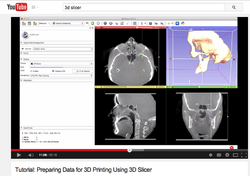
|
Slicer4 Image Registration
|
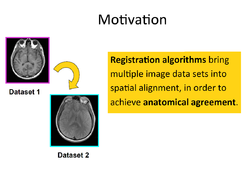
|
- Based on: 3D Slicer version 4.5
See the Registration Library for worked out registration examples with data.
Fast GrowCut
|

|
Slicer4 Radiation Therapy Tutorial
- The SlicerRT tutorial is an introduction to the Radiation Therapy functionalities of Slicer.
- Author: Csaba Pinter, Andras Lasso, An Wang, Gregory C. Sharp, David Jaffray, Gabor Fichtinger.
- Dataset: download from MIDAS
- Based on Slicer 4.6
Other
Additional (non-curated) videos-based demonstrations using 3D Slicer are accessible on You Tube.
3D Slicer Tutorial contests
Winter 2017 Tutorial contest
Segmentation for 3D printing
|
Slicer Pathology
|
Simple Python Tool for Quality Control of DWI data
|
SPHARM-PDM
|
Integration of Robot Operating System (ROS) and 3D Slicer using OpenIGTLink
|
Fiber Bundle Volume Measurement
|
Winter 2016 Tutorial contest
Subject Hierarchy
|
Fiber Bundle Selection and Scalar Measurements
|
Plastimatch
|
UKF
|
Summer 2014 Tutorial contest
Cardiac Agatston Tutorial
|
CMR Toolkit LA workflow
|
Summer 2013 Tutorial contest
Cardiac MRI Toolkit
|
HelloCLI
|
SlicerRT
|
DTIPrep
|
Summer 2012 Tutorial contest
Automatic Left Atrial Scar Segmenter
|
Qualitative and Quantitative Comparison of Two RT Dose Distributions
|
Dose Accumulation for Adaptive Radiation Therapy
|
WebGL Export
|
OpenIGTLink
|
Additional resources
|
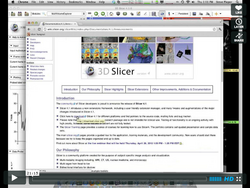
|
|
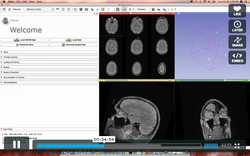
|
|
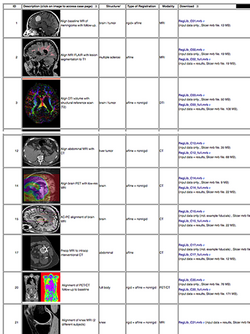 |} |}
External ResourcesMurat Maga's blog posts about using 3D Slicer for biologyUsing the (legacy) EditorThis set of tutorials about the use of slicer in paleontology is very well written and provides step-by-step instructions. Even though it covers slicer version 3.4, many of the concepts and techniques have applicability to the new version and to any 3D imaging field:
Team ContributionsSee the collection of videos on the Kitware vimeo album. User ContributionsSee the User Contributions Page for more content. |
